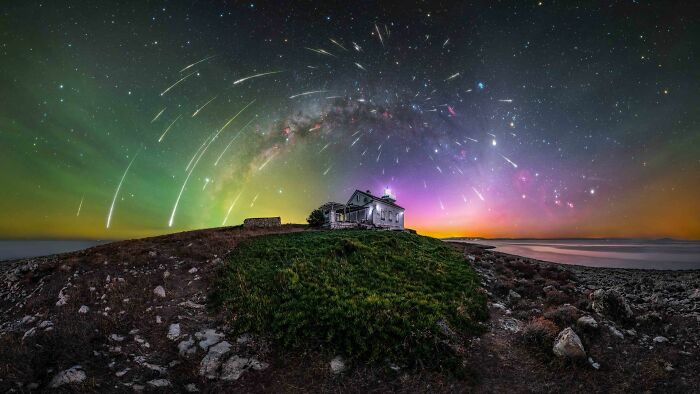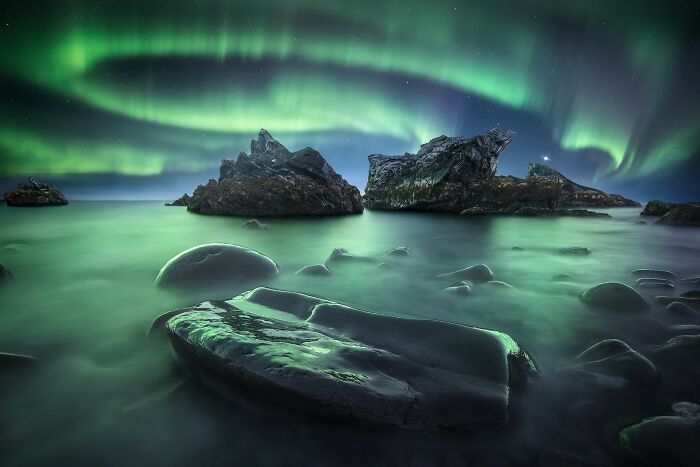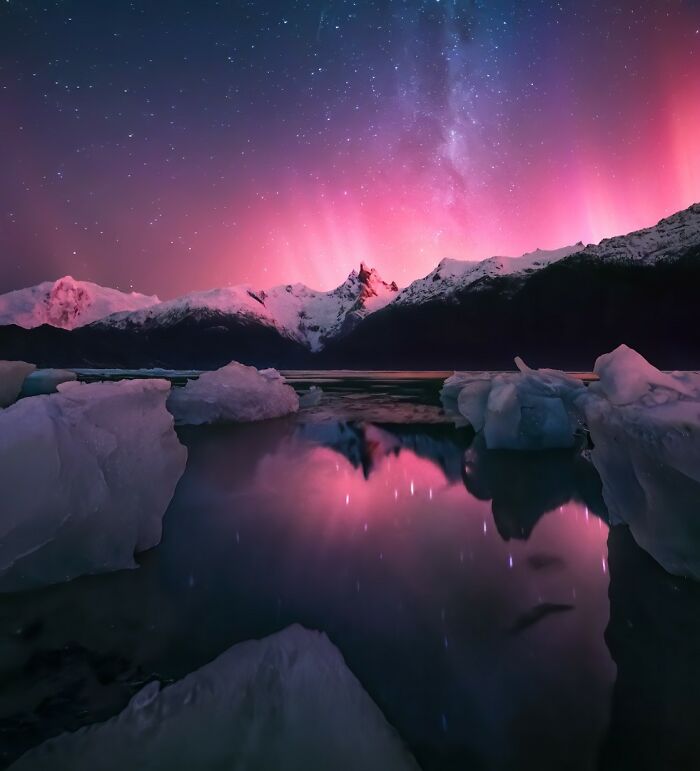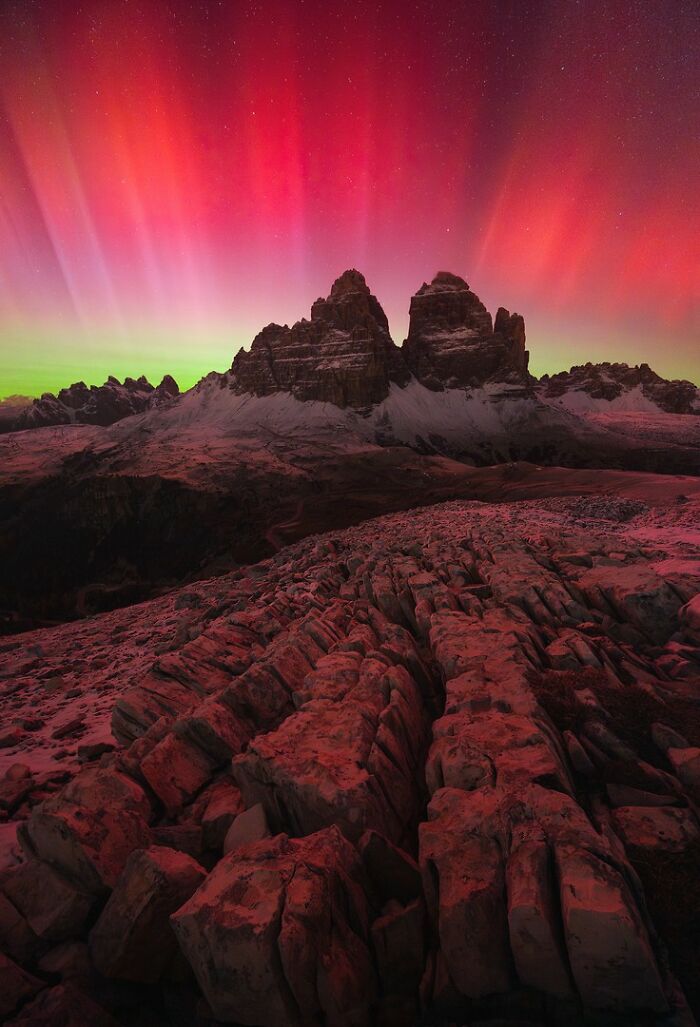As 2024 is coming to an end, there’s something special about reflecting on the year through a collection of photographs captured along the way. This time, we are sharing the 7th edition of the annual Northern Lights Photographer of the Year published by the travel photography blog Capture the Atlas.
The photos were taken around the world, in countries like the UK, the United States, Canada, Germany, France, Italy, Spain, Portugal, Croatia, Latvia, Iceland, Russia, Chile, Namibia, Australia, and New Zealand, by 25 photographers of 15 different nationalities.
We invite you to immerse yourselves in the beauty of the Northern Lights brought to you closer in order to learn and discover more about one of nature’s most spectacular light shows. And for more photos, you can take a look at the previous year’s post.
“Sky Fire” – Tom Rae

Aoraki/Mt. Cook National Park, New Zealand.
“The Milky Way arches over the dramatic landscape of Aoraki Mount Cook National Park, captured during a rare G5 geomagnetic storm in May 2024. This aurora display was one of the most breathtaking sights I’ve ever witnessed—a magical evening watching the lights dance across the crystal-clear sky. The excitement was shared by everyone under the stars, as this aurora was potentially the strongest in a century.
The image features a rare SAR (Stable Auroral Red) arc, an atmospheric phenomenon that added to the spectacle, alongside the glow of billions of stars in the Milky Way. Capturing this moment was technically challenging, but it resulted in one of the most unique depictions of the aurora from New Zealand. This photograph is not just an image but a treasured memory of an extraordinary and ethereal night.”
I really wished I could see the May 9th Aurorae. I’ve only seen some in Iceland, and they’re actually just so insane.
To learn more about this year’s contest, Bored Panda reached out to Dan, the Editor in Chief, who kindly answered our questions.
First of all, Dan commented on the solar activity this year and how it affected the Northern Lights photos.
“This year, heightened solar activity has resulted in some of the most vibrant and dynamic aurora displays in recent memory. Photographers were able to capture intense bursts of color, including rare shades like deep purples and vibrant reds, thanks to the strong geomagnetic storms.
The increased activity also expanded visibility further south than usual, allowing more people—and photographers in unexpected regions—to witness and document the spectacle. As a result, the photos submitted this year have showcased a remarkable variety of auroras, both in terms of intensity and geographic range, making this collection especially diverse,” wrote Dan.
“When The Aurora Meets The Milky Way” – Jānis Paļulis

Bauska, Latvia.
“On that night, I had originally planned to photograph the Perseid meteor shower, but the aurora forecast also looked promising, though it wasn’t my main focus at the time. I took a few photos of the stars, and then I noticed a pink glow in the corner of the sky. It was the aurora! I pointed my camera toward the southwest and took my best shot. The weather conditions were perfect, with fog adding to the atmosphere. Around midnight, the aurora display became truly stunning.”
“Cosmic Explosion” – Uroš Fink

Istria, Croatia.
“On the night of the Perseid meteor shower, I was treated to a “multi-course menu” of the night sky. I captured the Milky Way arch with Orion, the Aurora (a first for me), the Zodiacal light, and the Perseid meteors. As if that wasn’t enough, the sky gifted me with one of the most stunning greenish airglows I’ve ever seen. Oh, and I almost forgot to mention the close conjunction of Jupiter and Mars, right along the path of the Zodiacal light.
In the center of the panorama is the Cap Marlera lighthouse, built in 1880 at the southeastern tip of the Istrian Peninsula. The rugged coastline, at the entrance to Kvarner, attracts fish and dolphins. This area is also home to the Mediterranean bear, though I didn’t have the pleasure of meeting one.
Meteors rained down throughout the night, and I captured 75 of them using three cameras. I used the RegiStar software to seamlessly insert the meteors to the panorama in the exactly same spots as they appeared in the sky this night.
It was an extraordinary, perhaps once-in-a-lifetime event, and I’m grateful and happy to have been part of it.”
The Perseids are some of the best meteor showers. And with this Aurora, the Zodiacal light. (Orion is the one with big red splotches around the stars in the bottom right. This appears to be near the end of spring, as Orion is near the end. And hell yeah it’s a one-in-a-lifetime event. It’s pretty damned awesome for sure
We were wondering which locations stood out in this year’s competition. Dan shared: “Some of the most unexpected submissions came from places not traditionally associated with the Northern Lights, like southern parts of the United States, Southern Europe, Patagonia, etc. These locations stood out not just because of their rarity but because they demonstrated how far-reaching the aurora became during heightened solar activity.
Another standout was Namibia, where a rare and faint auroral display coincided with stunning desert landscapes, offering a unique juxtaposition of the night sky and arid terrain. These surprising locales remind us of the unpredictable and global nature of solar phenomena, making this year’s collection truly exceptional.”
“In The Rays Of The Solar Wind” – Sergey Korolev

Rybachy Peninsula, Russia.
“The Rybachy Peninsula, where this photo was taken, is located at the northern edge of the Kola Peninsula. It’s a unique natural area, home to many fascinating locations with numerous stone beaches and rocks featuring unusual shapes and structures. I fell in love with this place during my first visit 10 years ago, and now, every year, I try to return and capture something new.
For this shot, I wanted to create a concept that emphasized the significance of the location, with the Northern Lights serving as a complement to the landscape. This time, the aurora was particularly powerful, casting a beautiful light over the stones. The photo is quite simple, composed of three main exposures: the first for capturing the sky, the second for the rest of the scene, and the third for focusing on the foreground.”
“Aurora Australis” – Marc Adamus

Patagonia Fjords, Chile.
“I’m not sure if an aurora had ever been recorded in Patagonia before, but we got incredibly lucky on the night of May 10, 2024, when a G5 storm hit. We were camped on an iceberg beach, deep in the wilderness of the Patagonia Fjords, when the incredible display unfolded.”
I’ve always wanted to see the northern lights in person but never got a chance to. My mom took me to a place in Louisiana to see the northern lights but the moon was too bright to see them. Some day I will get to see the northern lights.
As for the challenges that photographers faced in unusual places like Namibia and Arizona, Dan wrote: “Photographers in these unconventional locations faced a host of challenges, including light pollution and unfamiliar weather conditions.
In Namibia, for instance, capturing faint auroras against a dark desert sky required precise settings and patience, as the display was much subtler than in polar regions. In Arizona, photographers contended with atmospheric interference and warmer temperatures, which can affect camera equipment during long exposures. Despite these obstacles, their perseverance resulted in unique and breathtaking compositions that highlight the versatility and creativity of aurora photography.”
“Coronation” – Roksolyana Hilevych

Dolomites, Italy.
“That day, after a storm of mixed snow and rain, the sky fortunately cleared after 8 p.m. (about an hour after sunset). As I walked to my location, I could already see red hues peeking through the clouds. The adrenaline and excitement were so overwhelming that I hardly noticed the cold and strong wind, which never let up during the night at 2,450 meters above sea level.
I ended up taking 840 photos from 8:30 p.m. to 5 a.m., hoping to capture the perfect moment. This photo was taken around 1:30 a.m., during the second peak of the aurora, the strongest ever, which lasted only a few seconds.”


